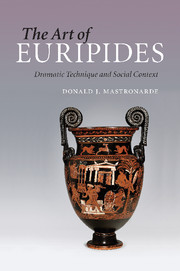Book contents
- Frontmatter
- Contents
- Preface
- Abbreviations and reference system
- 1 Approaching Euripides
- 2 Problems of genre
- 3 Dramatic structures: variety and unity
- 4 The chorus
- 5 The gods
- 6 Rhetoric and character
- 7 Women
- 8 Euripidean males and the limits of autonomy
- Conclusion
- Bibliography
- Index of names and topics
- Index of passages cited
3 - Dramatic structures: variety and unity
Published online by Cambridge University Press: 04 May 2010
- Frontmatter
- Contents
- Preface
- Abbreviations and reference system
- 1 Approaching Euripides
- 2 Problems of genre
- 3 Dramatic structures: variety and unity
- 4 The chorus
- 5 The gods
- 6 Rhetoric and character
- 7 Women
- 8 Euripidean males and the limits of autonomy
- Conclusion
- Bibliography
- Index of names and topics
- Index of passages cited
Summary
In the same way that a narrow and prescriptive concept of genre can do a disservice to our understanding of Euripidean drama, so, too, some prevalent assumptions about structure and unity have tended to encourage a devaluation of Euripides' achievements as a dramatist. The strongest influence, of course, has been exercised by the Aristotelian model of “organic” unity with a tight linear connection by “probability or necessity” from beginning to end of a plot. Aristotle's interest in a hierarchical ranking of artistic possibilities has also played a role, as has his backhanded compliment at Poetics 13.1453a29–30: “Euripides, even if he does not manage other aspects well, yet appears to be the most tragic of the poets” (emphasis added). In defending tragedy against Plato's strictures, which attack the emotional seductiveness of mimetic poetry and condemn the mimetic artist as lacking true knowledge, Aristotle has a vested interest in emphasizing the intelligibility of tragic plotting in terms of cause and effect and in terms of consistency and appropriateness of character. Aristotle's approach privileges the author of the plot as the creator of a readily readable structure that evokes certain properly tragic responses (pity, fear; also ekplēxis, “astonishment”), but at the same time restricts the freedom of such artists. What such an approach tends to underestimate is the opaqueness and difficulty (and at times playfulness) of most Greek tragedies, qualities that present a challenge to the audience and invite a more open-ended process of reception.
Information
- Type
- Chapter
- Information
- The Art of EuripidesDramatic Technique and Social Context, pp. 63 - 87Publisher: Cambridge University PressPrint publication year: 2010
